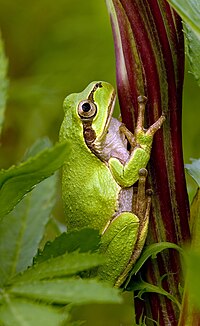
Photo from wikipedia
Predation risk is among the key forces driving the evolution of escape behaviours and related phenotypes. Successful avoidance of predators results in increased survival rate and fitness. The behavioural response… Click to show full abstract
Predation risk is among the key forces driving the evolution of escape behaviours and related phenotypes. Successful avoidance of predators results in increased survival rate and fitness. The behavioural response of individuals under predation pressure has been comparatively well studied, however, most studies focus on specific escape behaviours and not on behavioural plasticity. The American bullfrog (Lithobates catesbeianus) has been an invasive species in the Republic of Korea since the 1970s and has a negative impact on local species. Here, we evaluated the functions of microhabitat preference and behavioural plasticity in L. catesbeianus tadpoles through manipulative experiments. In a first experiment, we placed wildcaught tadpoles with a local predatory fish (Channa argus) into one of three microhabitat treatments: non-vegetated, submerged vegetation, or floating vegetation. The survival rate of tadpoles with submerged vegetation was significantly higher than that in the non-vegetated microhabitat. In contrast, the survival rates of tadpoles with floating vegetation was not significantly different from the two other treatments. In the habitat preference experiment, “unhurt” and “wounded” wildcaught tadpoles were given a choice between the three microhabitat treatments. Both types of tadpoles preferentially selected the submerged vegetation microhabitat compared to the non-vegetated microhabitat. In contrast, only wounded tadpoles significantly preferred floating vegetation over non-vegetated microhabitats. We conclude that L. catesbeianus tadpoles prefer vegetated microhabitats, and especially submerged vegetation. Furthermore, L. catesbeianus tadpoles can adjust their antipredatory behaviour according to previous experience, and thus demonstrate behavioural plasticity by using microhabitats that they do not use in the absence of predators.
Journal Title: Aquatic Invasions
Year Published: 2019
Link to full text (if available)
Share on Social Media: Sign Up to like & get
recommendations!